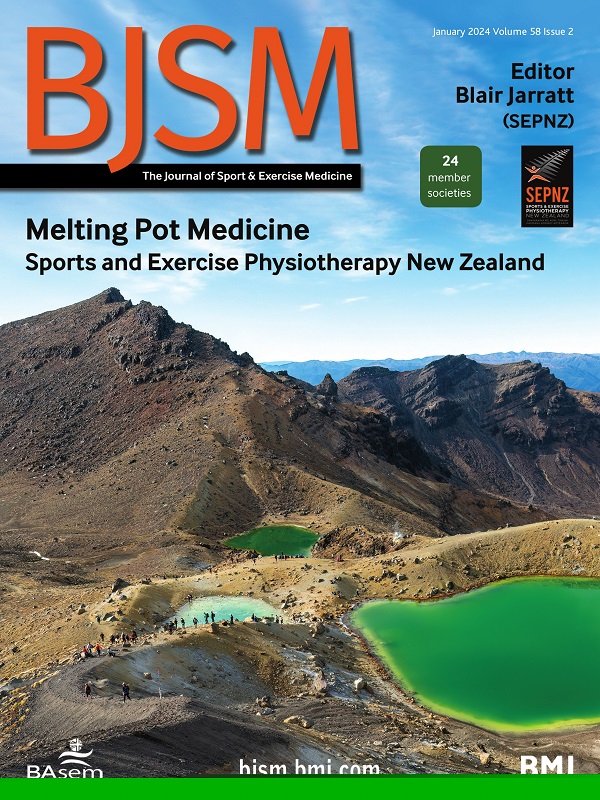Role of sit-to-stand muscle power in healthy ageing: assessing validity, clinical relevance, decline and interventions in older adults with and without chronic conditions (PhD Academy Award)
IF 11.6
1区 医学
Q1 SPORT SCIENCES
引用次数: 0
Abstract
This PhD thesis aimed: (i) to assess the validity of the sit-to-stand (STS) muscle power test and compare it with other equations available in the literature; (ii) to investigate the functional implications of having low relative STS power (ie, normalised by body mass) in older individuals with and without Parkinson’s disease (PD); (iii) to assess longitudinal changes in relative STS power and its contributing factors, providing clinically relevant cut-off points for low relative STS power; and (iv) to evaluate the short-term and residual effects of power-oriented resistance training (RT) combined with high-intensity interval training (HIIT) in frail older adults and in those with chronic obstructive pulmonary disease (COPD). Muscle power, a critical component of the neuromuscular system, declines more rapidly than muscle mass and strength with ageing and is a stronger predictor of adverse health outcomes, including frailty, disability, and falls. However, the lack of feasible and valid tests, normative values and cut-off points has so far prevented its evaluation in the clinical setting. Given the WHO’s emphasis on healthy ageing and maintaining functional ability, it is essential to identify and implement effective strategies to assess and enhance muscle power, thereby supporting independence and well-being in older populations. Thus, the validity and clinical relevance of the STS muscle power test deserved to be investigated. My PhD thesis comprised eight studies, including cross-sectional (studies 1–4), an 8-year longitudinal (study 5) and interventional (studies 6–8) designs. Participants included 2183 community-dwelling older adults (>65 years), 46 age- and sex-matched individuals with and without PD (>60 years), 59 older adults with frailty (>70 years) and 21 older adults with COPD (>65 years). Relative STS power was evaluated using the STS muscle …坐立肌力在健康老龄化中的作用:评估有效性、临床相关性、衰退和干预措施在有和没有慢性疾病的老年人中(博士学院奖)
本博士论文旨在(i) 评估坐立(STS)肌力测试的有效性,并将其与现有文献中的其他公式进行比较;(ii) 研究帕金森病(PD)患者和非帕金森病(PD)患者中相对STS肌力低(即按体重归一化)的功能影响;(iii) 评估相对 STS 功率的纵向变化及其诱因,提供与临床相关的低相对 STS 功率临界点;以及 (iv) 评估以功率为导向的阻力训练(RT)结合高强度间歇训练(HIIT)对体弱老年人和慢性阻塞性肺病(COPD)患者的短期和残余影响。肌肉力量是神经肌肉系统的重要组成部分,随着年龄的增长,肌肉力量的下降速度比肌肉质量和力量的下降速度更快,也更能预测包括虚弱、残疾和跌倒在内的不良健康后果。然而,由于缺乏可行、有效的测试、标准值和临界点,迄今为止还无法在临床环境中对其进行评估。鉴于世界卫生组织对健康老龄化和保持功能能力的重视,必须确定并实施有效的策略来评估和增强肌肉力量,从而支持老年人群的独立性和福祉。因此,STS 肌肉力量测试的有效性和临床相关性值得研究。我的博士论文由八项研究组成,包括横断面研究(研究 1-4)、为期 8 年的纵向研究(研究 5)和干预性研究(研究 6-8)。研究对象包括 2183 名居住在社区的老年人(年龄大于 65 岁)、46 名年龄和性别匹配的患有和不患有帕金森病的老年人(年龄大于 60 岁)、59 名患有虚弱症的老年人(年龄大于 70 岁)和 21 名患有慢性阻塞性肺病的老年人(年龄大于 65 岁)。用STS肌肉力量来评估STS的相对力量...
本文章由计算机程序翻译,如有差异,请以英文原文为准。
求助全文
约1分钟内获得全文
求助全文
来源期刊
CiteScore
27.10
自引率
4.90%
发文量
217
审稿时长
3-8 weeks
期刊介绍:
The British Journal of Sports Medicine (BJSM) is a dynamic platform that presents groundbreaking research, thought-provoking reviews, and meaningful discussions on sport and exercise medicine. Our focus encompasses various clinically-relevant aspects such as physiotherapy, physical therapy, and rehabilitation. With an aim to foster innovation, education, and knowledge translation, we strive to bridge the gap between research and practical implementation in the field. Our multi-media approach, including web, print, video, and audio resources, along with our active presence on social media, connects a global community of healthcare professionals dedicated to treating active individuals.

 求助内容:
求助内容: 应助结果提醒方式:
应助结果提醒方式:


